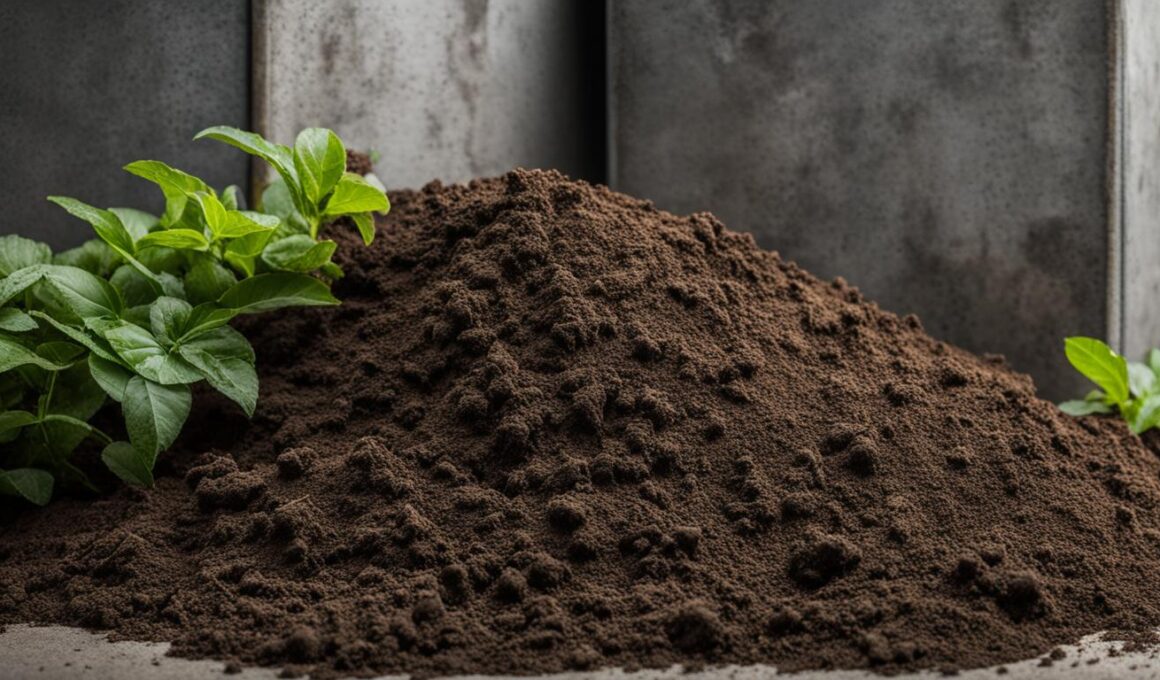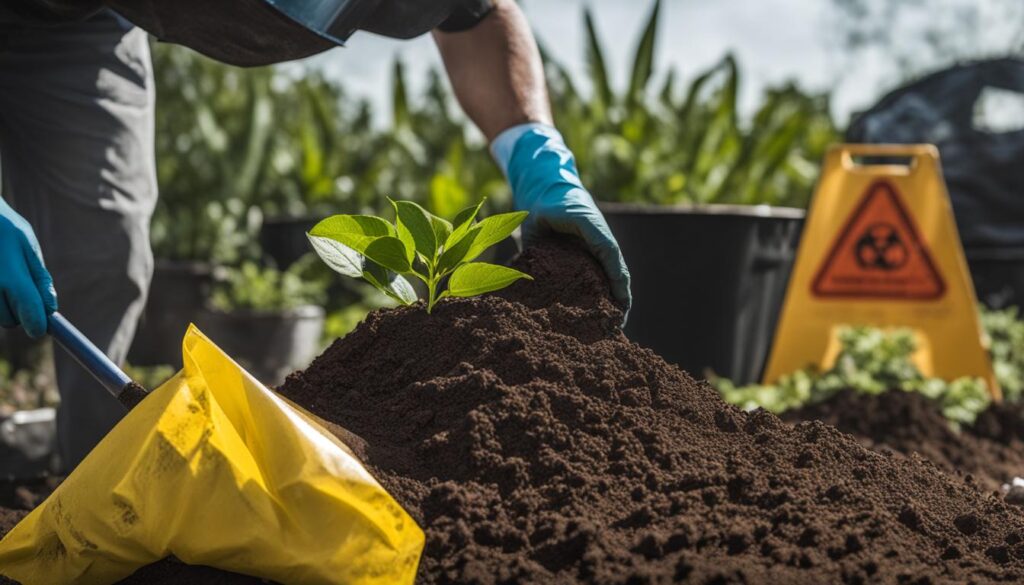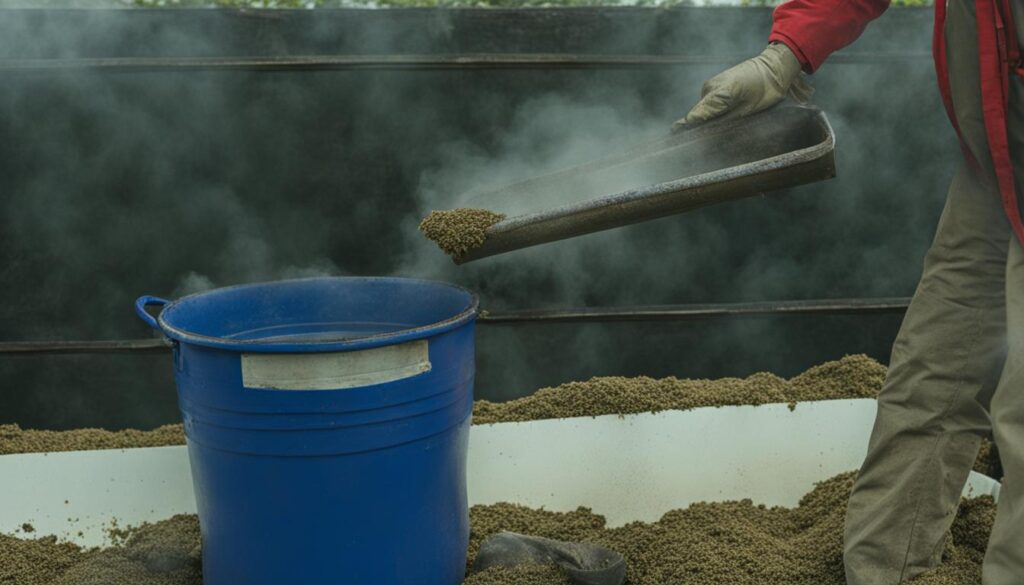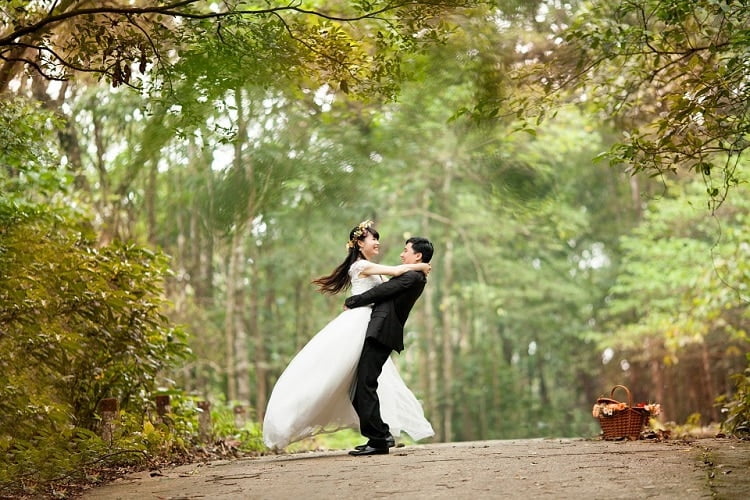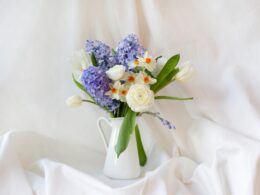If you have old potting soil after your plants have died, you may be wondering how to dispose of it properly. Luckily, there are several options available to you. Whether you choose to store it for next season, take it to a yard waste drop-off program, add it to your compost, or mix it into your flower garden beds, this quick guide will help you make an informed decision based on the condition of your soil and any disease issues it may have.
Post Summary
- Storing old potting soil in a sealable container is a good option if you plan to use it in the future.
- Yard waste drop-off programs are available in many cities for the disposal of old potting soil.
- Adding old potting soil to your compost pile is a sustainable way to recycle it.
- Mixing old potting soil into flower garden beds can improve soil structure and drainage.
- If your potting soil has disease issues, it is best to discard it and sterilize the flowerpots.
Storing Old Potting Soil for Next Season
To store old potting soil for future use, you can follow these simple steps:
- Gather the necessary materials: You will need a sealable container, such as an old garbage can, to store the soil. Make sure the container is clean and free from any chemicals or contaminants.
- Prepare the soil: Before storing the soil, remove any plant debris, rocks, or other unwanted materials. You may also choose to break up any clumps to help with storage and future use.
- Fill the container: Place the prepared soil into the sealable container, ensuring it is evenly distributed. Leave some space at the top for proper sealing.
- Seal the container: Close the lid tightly to prevent pathogens, insects, and moisture from entering the container. This will help preserve the quality of the soil during storage.
- Label the container: It is a good practice to label the container with the date and the type of soil it contains. This will help you keep track of its storage time and contents.
- Store in a cool, dry place: Find a suitable location, such as a garage or shed, where the container can be stored away from extreme temperatures and excessive moisture.
- Check periodically: Throughout the storage period, it is advisable to check the soil occasionally for any signs of mold, pests, or unusual odors. If any issues arise, it may be best to dispose of the soil instead of reusing it.
By following these steps, you can store your old potting soil for next season, ensuring its usability and avoiding any potential negative impacts on your plants.
| Storage Method | Advantages | Disadvantages |
|---|---|---|
| Sealable Container | Provides protection from pathogens and insects | Requires additional storage space |
| Yard Waste Drop-Off | Easy and convenient disposal method | May not be available in all areas |
| Composting | Contributes to nutrient-rich compost | Takes time for the soil to decompose |
| Adding to Garden Beds | Improves soil structure and drainage | May not provide sufficient nutrients |
Taking Old Potting Soil to a Yard Waste Drop-Off Program
If you’re looking for a convenient and eco-friendly way to dispose of your old potting soil, consider taking it to a yard waste drop-off program. Many cities offer these programs, allowing residents to responsibly dispose of their organic waste. Not only does this help to reduce landfill waste, but it also contributes to the creation of nutrient-rich compost.
Yard waste drop-off programs typically accept a variety of organic materials, including leaves, branches, and garden waste. Some programs may explicitly mention the acceptance of potting soil, while others may not specify it. It’s a good idea to check your city’s website or contact the waste management department to confirm whether they accept potting soil specifically.
When taking your old potting soil to a drop-off program, make sure to follow any instructions provided. This may include bagging the soil or placing it in specific containers. By adhering to these guidelines, you can ensure a smooth drop-off experience and help the composting process.
Benefits of Yard Waste Drop-Off Programs
- Reduce landfill waste by diverting organic materials
- Promote the creation of nutrient-rich compost
- Contribute to a sustainable and eco-friendly community
- Support local initiatives for waste reduction and recycling
By taking advantage of yard waste drop-off programs, you can play a part in reducing waste and contributing to a healthier environment. Dispose of your old potting soil responsibly and help create a greener future for your community.
| Yard Waste Drop-Off Program | Composting | Mixing into Garden Beds | Other Options | |
|---|---|---|---|---|
| Convenience | Convenient and accessible in many cities | Requires a compost pile or bin | Requires access to garden beds | Varies depending on the option chosen |
| Environmental Impact | Reduces landfill waste and contributes to composting | Reduces waste and creates nutrient-rich compost | Improves soil structure and drainage | Varies depending on the option chosen |
| Soil Condition | Accepts potting soil of any condition | Best for healthy soil without disease issues | Best for improving garden bed structure | Varies depending on the option chosen |
| Future Use | Potting soil is composted for future use | Compost can be used in gardens or as a soil amendment | Improves garden bed soil for future planting | Varies depending on the option chosen |
Adding Old Potting Soil to Compost
If you have a compost pile, adding old potting soil to it can be a smart and sustainable choice. By incorporating the soil into your compost, you not only reduce waste but also contribute to the overall nutrient content of the compost. Before adding the old soil, make sure to break up any clumps and mix it with other compostable materials to promote proper decomposition.
When blending the old potting soil with your compost, aim for a ratio of approximately 1 part old soil to 2 parts organic matter. This ensures that the compost remains well-balanced and provides the necessary nutrients for your plants. Additionally, mixing the old soil with other organic materials helps improve the structure and moisture retention capabilities of the compost.
The key to successfully incorporating old potting soil into your compost is to create a balanced blend of organic matter. By doing so, you’ll be able to transform the old soil into nutrient-rich compost that can support the growth of future plants.
Remember to regularly turn your compost pile to facilitate decomposition and aerate the mixture. This allows the beneficial microorganisms to break down the organic matter, including the old potting soil, more efficiently. Over time, you’ll have a rich and fertile compost that can be used to enhance the quality of your garden soil.
Comparing Nutrient Levels in Old Potting Soil and Compost
| Nutrient | Old Potting Soil | Compost |
|---|---|---|
| Nitrogen | Low | High |
| Phosphorus | Medium | Medium-High |
| Potassium | Low | High |
| Microorganisms | Low | High |
By adding old potting soil to your compost, you can transform it into a nutrient-rich resource that benefits your plants and helps improve your garden’s overall health. Remember to follow proper composting practices and monitor the moisture levels to ensure successful decomposition. With a little effort, you’ll be able to recycle your old potting soil and create a thriving, sustainable garden environment.
Mixing Old Potting Soil into Flower Garden Beds
When it comes to reusing old potting soil, one option is to mix it into your flower garden beds. While the nutritional value of the soil may be depleted, it can still have benefits for your plants. By incorporating the old soil into your garden beds, you can improve the structure of the soil, enhance water drainage, and create a healthier environment for your plant roots to thrive.
To effectively mix your old potting soil into your garden beds, follow these steps:
- Prepare the area: Clear any existing weeds or debris from the flower beds to create a clean slate for mixing in the old potting soil.
- Break up clumps: If your old potting soil has clumps, break them apart using a garden fork or your hands. This will ensure an even distribution of soil throughout the bed.
- Spread the soil: Lightly spread the old potting soil over the top of the existing garden bed. Avoid piling it too thickly, as this can create a barrier that may hinder plant growth.
- Mix the soil: Gently incorporate the old potting soil into the existing soil using a garden rake or a handheld cultivator. Be careful not to disturb the roots of any existing plants or flowers.
By mixing your old potting soil into your flower garden beds, you can repurpose it and give it new life. This sustainable approach not only reduces waste but also helps improve the overall health and productivity of your garden.
| Benefits of Mixing Old Potting Soil into Flower Garden Beds |
|---|
| Improves soil structure |
| Enhances water drainage |
| Promotes healthier plant root growth |
| Reduces waste by repurposing old soil |
Quote: “Mixing old potting soil into your flower garden beds is a great way to recycle and improve the soil. It’s like giving your plants a fresh start with a nutrient boost.” – Gardening Expert
Disposing of Potting Soil with Disease Issues
If your flowers had disease issues at the end of the season, it is best to discard all the contents of the flowerpot, including the potting soil. Disease can carry over from one year to the next, potentially affecting future plants. To prevent spreading diseases, it is advisable to dispose of the soil and sterilize the flowerpots. Follow the guidelines provided by your local waste management services for proper disposal.
Disposing of Potting Soil with Disease Issues
If your flowers had disease issues at the end of the season, it is best to discard all the contents of the flowerpot, including the potting soil. Disease can carry over from one year to the next, potentially affecting future plants. To prevent spreading diseases, it is advisable to dispose of the soil and sterilize the flowerpots. Follow the guidelines provided by your local waste management services for proper disposal.
“If your flowers had disease issues at the end of the season, it is best to discard all the contents of the flowerpot, including the potting soil. Disease can carry over from one year to the next, potentially affecting future plants. To prevent spreading diseases, it is advisable to dispose of the soil and sterilize the flowerpots. Follow the guidelines provided by your local waste management services for proper disposal.”
If your flowers had disease issues at the end of the season, it is best to discard all the contents of the flowerpot, including the potting soil. Disease can carry over from one year to the next, potentially affecting future plants. To prevent spreading diseases, it is advisable to dispose of the soil and sterilize the flowerpots. Follow the guidelines provided by your local waste management services for proper disposal.
| Methods of Disposing Potting Soil with Disease Issues | Advantages | Disadvantages |
|---|---|---|
| Local Waste Management Services | – Proper disposal in accordance with guidelines – Prevents spreading diseases |
– May require additional fees – Limited disposal options |
| Compost Facilities | – Contributes to creating nutrient-rich compost – Environmentally friendly |
– May not accept potting soil with diseases – Limited availability in some areas |
| Professional Landscaping Services | – Expert handling and disposal – Ensures proper infection control |
– Costly option – Dependent on local service availability |
When disposing of potting soil with disease issues, it is crucial to prioritize the health of your plants and future gardening endeavors. By following proper disposal methods and sterilizing contaminated flowerpots, you can help prevent the spread of diseases and create a fresh start for your gardening projects.
Sterilizing Old Potting Soil for Reuse
If you’re determined to reuse old potting soil despite any disease or insect issues, sterilizing it can be a consideration. Sterilization involves heating the soil to eliminate pathogens and pests, ensuring a safer environment for your plants. While this technique is not commonly practiced, it can help salvage old soil that still has some value. It’s important to weigh the benefits and risks before deciding to sterilize your old potting soil.
Sterilization can be done by baking the old soil in the oven at a temperature of 180°F (82°C) for about 30 minutes. This heat treatment kills off most pathogens and pests. However, keep in mind that this process can also destroy beneficial microorganisms that contribute to the soil’s fertility. Therefore, it’s essential to reintroduce beneficial microorganisms to the soil after sterilization. Adding compost or organic matter can help replenish the soil’s microbial activity.
Before sterilizing your old potting soil, assess its quality and potential for reuse. If the soil is severely depleted or contaminated, it may be more effective to start fresh with new potting soil. However, if the soil still has some nutrients and structure, sterilization can be a viable option to extend its usefulness. Remember to always practice good hygiene when handling old potting soil to prevent the spread of diseases or pests.
Benefits of Sterilizing Old Potting Soil
- Eliminates pathogens and pests: Sterilization effectively kills off harmful organisms that may affect your plants.
- Reuse of valuable resources: Sterilizing and reusing old potting soil reduces waste and promotes sustainability.
- Cost-effective: Reusing sterilized soil saves money compared to purchasing new potting soil.
While sterilizing old potting soil can be a beneficial practice, it’s important to consider the overall condition of the soil and any potential risks involved. Make an informed decision based on your specific gardening needs and preferences.
Tips for Reusing Old Potting Soil
When it comes to reusing old potting soil, there are a few key tips to keep in mind to ensure success. By following these recommendations, you can make the most out of your old potting soil and create a thriving environment for your plants.
Break Apart Clumps and Mix
Before using old potting soil, it’s important to break apart any clumps that may have formed. This allows for better aeration and prevents water from pooling around the clumps, which can lead to root rot. Use your hands or a small garden tool to crumble the soil into smaller particles.
After breaking apart the clumps, mix the old potting soil with fresh potting soil or compost. This helps replenish essential nutrients and organic matter that may have been depleted over time. Aim for a ratio of around 50% old soil and 50% fresh soil or compost, but adjust as needed based on the overall quality of the old soil.
Blend in Slow-Release Fertilizer
If you’re reusing old potting soil, it’s a good idea to incorporate slow-release fertilizer into the mix. This type of fertilizer gradually releases nutrients over time, providing a steady source of food for your plants. Follow the manufacturer’s instructions for application rates, and ensure the fertilizer is evenly distributed throughout the soil before planting.
Consider Supplementing with additional Nutrients
Depending on the specific needs of your plants, you may also want to consider supplementing the old potting soil with additional nutrients. This can be done by adding granular or liquid fertilizers specific to the types of plants you’ll be growing. Be sure to carefully read and follow the instructions on the product labels to avoid over-fertilizing and causing harm to your plants.
By breaking apart clumps, mixing in fresh soil or compost, blending in slow-release fertilizer, and considering supplemental nutrients, you can effectively reuse old potting soil and provide a favorable environment for your plants’ growth.
Conclusion
Disposing of old potting soil can be done in several ways, depending on its condition and any disease issues it may have. Whether you choose to store it, take it to a yard waste drop-off program, add it to compost, or mix it into your garden beds, the goal is to promote sustainability and reduce waste. By considering the best option for your situation, you can make use of your old potting soil in a productive and responsible manner.
If the soil is still viable, storing it for next season in a sealed container is a practical choice. This allows you to mix it with fresh potting soil or compost when the time comes. Yard waste drop-off programs provide another eco-friendly option, where the soil can be transformed into beneficial compost. Adding old potting soil to your compost pile contributes to its nutrient content and supports sustainable recycling.
Alternatively, mixing old potting soil into your flower garden beds can improve water drainage and create a better environment for plant roots. However, it is important to be cautious when dealing with soil that had disease issues. In such cases, it is best to discard the soil and sterilize the flowerpots to prevent the spread of diseases to future plants.
Remember, the key is to think about the best method based on your specific circumstances. By responsibly disposing of your old potting soil, you are not only reducing waste but also contributing to the sustainability of your gardening practices.
Can old potting soil be used in the process of turning granular fertilizer into liquid?
Yes, old potting soil can be used in the process of turn granular fertilizer into liquid. The organic matter in the potting soil helps to break down the granular fertilizer into a liquid form, making it easier for plants to absorb the nutrients.
FAQ
How should I store old potting soil for next season?
Place it in a sealable container, such as an old garbage can, to keep it safe from pathogens and insects.
Can I take old potting soil to a yard waste drop-off program?
Yes, many cities offer yard waste drop-off programs where you can dispose of old potting soil. Check with your city or nearby cities for availability.
Can I add old potting soil to my compost pile?
Yes, adding old potting soil to your compost pile allows it to decompose and contribute to the nutrient content of the compost.
How can I mix old potting soil into my flower garden beds?
Break up any clumps and mix the old soil into the garden beds to enhance water drainage and improve the soil structure.
What should I do if my old potting soil had disease issues?
It is best to discard all contents of the flowerpot, including the potting soil, to prevent the spread of diseases to future plants.
Can I sterilize old potting soil for reuse?
While it is possible to sterilize old potting soil, it is not commonly practiced. Consider the benefits and risks before deciding to sterilize.
What are some tips for reusing old potting soil?
Break apart clumps, blend it with fresh potting soil or compost, and ensure even distribution of nutrients for healthy plant growth.
Can old potting soil be reused in flower garden beds?
Yes, mixing old potting soil into flower garden beds can improve water drainage and create a better environment for plant roots.
How should I dispose of old potting soil?
The best method of disposal depends on the condition of the soil and whether there were any disease issues. Consider options such as storing it, taking it to a yard waste drop-off program, or adding it to compost.





